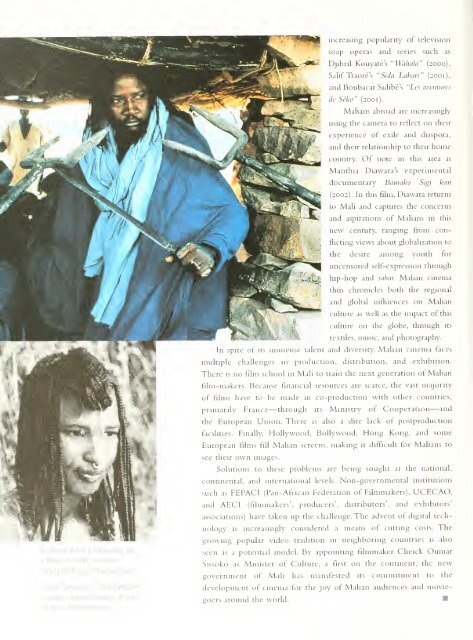SCOTLAND - Smithsonian Digital Repository - Smithsonian Institution
SCOTLAND - Smithsonian Digital Repository - Smithsonian Institution
SCOTLAND - Smithsonian Digital Repository - Smithsonian Institution
Create successful ePaper yourself
Turn your PDF publications into a flip-book with our unique Google optimized e-Paper software.
increasing popularity of television<br />
soap operas and series such as<br />
Djibril Kouyate's "Wahala" (2000),<br />
Salif Traore's "Sida Lakari" {2001),<br />
and Boubacar Sidibe's<br />
"Les aventures<br />
(ie Seko" (2001).<br />
Malians abroad are increasingly<br />
using the camera to reflect on their<br />
experience of exile and diaspora,<br />
and their relationship to their home<br />
country. Of note in this area is<br />
Manthia Diawara's experimental<br />
documentary Banuiko Sigi kan<br />
(2002). In this film, Diawara returns<br />
to Mali and captures the concerns<br />
and aspirations of Mahans in this<br />
new century, ranging from conflicting<br />
views about globahzation to<br />
the desire among youth for<br />
uncensored self-expression through<br />
"niij^ hip-hop and sabar. Malian cinema<br />
thus chronicles both the regional<br />
and global influences on Mahan<br />
culture as well as<br />
the impact of this<br />
culture on the globe, through its<br />
textiles, music, and photography.<br />
A scene from La Genese by<br />
Cheick Oumar Sissoko.<br />
Photo © Kmo International<br />
Aoua Sangare in<br />
Souleymane<br />
Cisse's classic Yeelen. Photo<br />
© Kmo International<br />
In spite lit ic~ immense talent and diversity, Malian cinema faces<br />
multiple challenges m production, distribution, and exhibition.<br />
There is no film school in Mali to train the next generation of Malian<br />
film-makers. Because financial resources are scarce, the vast majority<br />
of films have to be made in co-production with other countries,<br />
primarily France—through its Ministry of Cooperation—and<br />
the European Union. There is also a dire lack of postproduction<br />
facilities. Finally, Hollywood, Bollywood, Hong Kong, and some<br />
European films fill Malian screens, making it difficult for Malians to<br />
see their own images.<br />
Solutions to these problems are being sought at the national,<br />
continental, and international levels. Non-governmental institutions<br />
such as<br />
FEPACI (Pan-AfVican Federation of Filmmakers), UCECAO,<br />
and AECI (filmmakers', producers', distributors', and exhibitors'<br />
associations) have taken up the challenge. The advent of digital technology<br />
IS increasingly considered a means of cutting costs. The<br />
growing popular video tradition in neighboring countries is also<br />
seen as a potential model. By appointing filmmaker Cheick Oumar<br />
Sissoko as Minister of Culture, a first on the continent, the new<br />
government of Mali has manifested its commitment to the<br />
development of cinema for the joy of Malian audiences and moviegoers<br />
around the world.
















